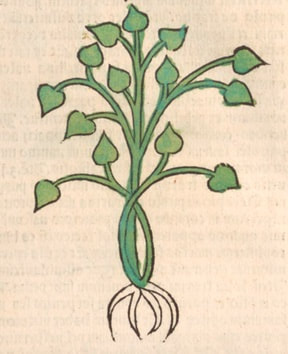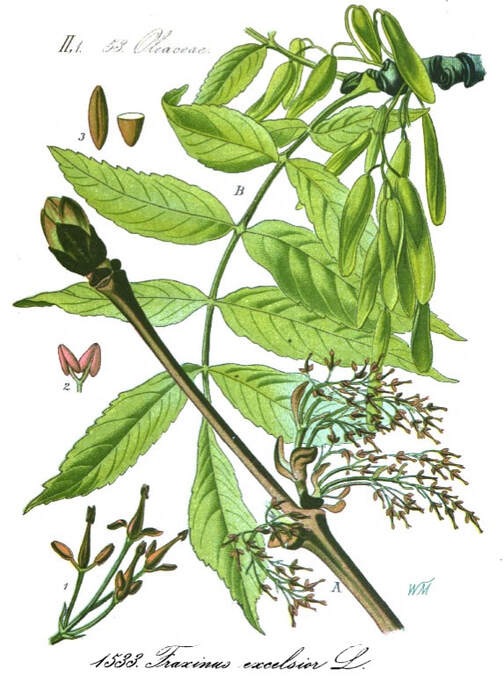Fraxinus, Ash
Ash tree fruit; Ash Keys, Samara of Ash, Linguae Avis, Lingua Avis, Ornithoglossa, Ornithoglossum
Manna (juice of the tree)
Manna (juice of the tree)
Herbarius latinus, Petri, 1485
|
Fraxinus excelsior
New Kreuterbuch, Matthiolus, 1563 |
Kreutterbuch, Matthiolus, 1586
|
Fraxinus excelsior
Flora von Deutschland (16), Kohler, 1884
Flora von Deutschland (16), Kohler, 1884
Botanical name:
Fraxinus excelsior
The Chinese Fraxinus rhynchophylla bark (Qin Pi) is used somewhat similarly. We have separated them due to the use of other parts of the Ash tree covered in this monograph.
Parts used:
Leaf; Wood; Bark; Seed ('Keys')
A little Manna is also collected from the common Ash.
Temperature & Taste:
Leaf & Bark: Neutral, dry. Bitter, Pungent
Seed: Warm, dry. Pungent
Bark is more astringent, leaf is more laxative, Seeds are more tonifying
Classifications:
BARK:
2L. EMOLLIENT
TCM:
B. Clears Heat and Damp
SEEDS ('Keys')
3J. INCREASE SEMEN
Fraxinus excelsior
The Chinese Fraxinus rhynchophylla bark (Qin Pi) is used somewhat similarly. We have separated them due to the use of other parts of the Ash tree covered in this monograph.
Parts used:
Leaf; Wood; Bark; Seed ('Keys')
A little Manna is also collected from the common Ash.
Temperature & Taste:
Leaf & Bark: Neutral, dry. Bitter, Pungent
Seed: Warm, dry. Pungent
Bark is more astringent, leaf is more laxative, Seeds are more tonifying
Classifications:
BARK:
2L. EMOLLIENT
TCM:
B. Clears Heat and Damp
SEEDS ('Keys')
3J. INCREASE SEMEN
Uses:
LEAF & BARK:
1. Clears Heat and Damp, Resists Poison:
-Dries; attenuates, mollifies
-hardness or obstruction of the Spleen or Liver
-Jaundice (Matthiolus)
-consumes 'evil Phlegm in man'. (Lonicerus, 1564)
-used for Intermittent Fevers
-Wood was called 'Guaiacum Germanicum' and was used as Guaiacum
-Snake bite (leaf juice taken or applied)
2. Clears Damp, Promotes Urine:
-Edema, Gravel, Stones (Matthiolus)
3. Clears Wind-Damp, Eases Pain:
-Arthritis, Rheumatism (bark, Mouchon)
-Muscle Pain and Rheumatic Pain (Leaf, Rademacher)
-'particularly successful in muscle and cranial rheumatism' (Leaf, Pouget, Marbotin et Otterbourg, 1862)
4. Externally:
-Salt of the Ashes was used int. and ext. for Wounds
-cleanses skin used externally (Matthiolus)
-bark ash applied for Leprosy (Dioscorides)
SEED:
1. Clears Heat and Damp, Benefits Liver:
-Liver disease, Hypochondriac Pain (Matthiolus)
-benefits the Liver
2. Warms the Kidneys, Clears Damp, Promotes Urine:
-Edema, Kidney Pain (Pliny)
-Stones
-Arthritis, Rheumatism (Mouchon)
-effective to reduce Obesity (Pliny)
3. Warms and Strengthens the Kidneys:
-Impotence; Premature Ejaculation; regarded as Aphrodisiac (Matthiolus)
-Nourishes Semen
-Promotes Fertility; used for Infertility
-'Restores decayed Nature' (Salmon)
4. Used in Pleurisy
-reportedly effective in Pleurisy
Dose:
Bark: 1.5–3 grams (half–1 dram); 1.5 grams (half dram) every 2 hours for Intermittent Fever
Leaf or Bark in Decoction: 3–9 grams
Seeds: 1–3 grams in Powder; 7 were given to an adult with wine.
Comment:
1. The Bark of the Chinese Ash Qin Pi is used very similarly to the European Ash bark. They are probably largely synonymous in use.
2. The various parts of the Ash tree are all drying and useful in Edema and urinary disorders. The bark is used in Arthritic disorders similarly to the Chinese Ash Qin Pi. Ash Tree 'Keys' (Seed) were common,y used in Aphrodisiac and Fertility formula to warm and strengthen the Kidneys.
Substitute:
Culpeper notes that if you can't get the leaves in Winter, then you may use the Bark. The Bark and Leaves can be used interchangeably.
Bark: 1.5–3 grams (half–1 dram); 1.5 grams (half dram) every 2 hours for Intermittent Fever
Leaf or Bark in Decoction: 3–9 grams
Seeds: 1–3 grams in Powder; 7 were given to an adult with wine.
Comment:
1. The Bark of the Chinese Ash Qin Pi is used very similarly to the European Ash bark. They are probably largely synonymous in use.
2. The various parts of the Ash tree are all drying and useful in Edema and urinary disorders. The bark is used in Arthritic disorders similarly to the Chinese Ash Qin Pi. Ash Tree 'Keys' (Seed) were common,y used in Aphrodisiac and Fertility formula to warm and strengthen the Kidneys.
Substitute:
Culpeper notes that if you can't get the leaves in Winter, then you may use the Bark. The Bark and Leaves can be used interchangeably.
Main Combinations:
1. Impotence, and as an aphrodisiac:
i. Ash tree keys, Nutmeg (Rhazes, Mesue)
ii. Ash tree keys with Orchis, Parsnip root, Sea Holly, Pine nut, Pistachio, Clove, Rocket seed, Cinnamon (as in Electuary of Orchid (Diasatyrion) of Nicholas)
iii. Ash tree keys with Triphala (3 Myrobalans), Trikatu (Long and Black Pepper, Ginger), Orchis, Sesame seed (as in Triphala Electuary Greater of Unani)
2. Infertility, Ash tree key with Parsnip seed, Turnip seed, Red Behen, White Behen, Cinnamon, Clove, Rosemary, Pennyroyal, Balm, Pearl (as in Confection for Impregnation of Renodeus)
3. Rheumatism and Osteoarthritis:
i. Ash leaf, Nettle leaf, Broom, Primula leaf (Kroeber)
ii. Ash leaf, Solidago, Populus tremula (proven as effective as NSAID's in mild to moderate cases)
Major Formulas:
Electuary of Orchid (Diasatyrion) (Nicholas)
Confection for Impregnation of Renodeus
Triphala Electuary Greater of Unani
Confection for Infertility from Cold
Cautions:
1. Leaf and Bark are very drying, so not suitable in Yin deficiency
2. Pliny said the follicules of the seed caused emaciation if taken in excess.
Main Preparations used:
Extract of the Bark, Oil Distilled from the Wood, Salt of the Ashes of the Bark, Pickled Seeds
1. Leaf and Bark are very drying, so not suitable in Yin deficiency
2. Pliny said the follicules of the seed caused emaciation if taken in excess.
Main Preparations used:
Extract of the Bark, Oil Distilled from the Wood, Salt of the Ashes of the Bark, Pickled Seeds
Click the Tabs above for more information on this Medicine
Pliny on Ash tree:
|
'We have already made some mention of the virtues possessed by the ash as an antidote to the venom of serpents. The seed of it is enclosed in follicules, which are good for diseases of the liver, and, in combination with wine, for pains in the sides: they are employed also for drawing off the water in dropsy. They have the property, too, of diminishing obesity, and of gradually reducing the body to a state of comparative emaciation, the follicules being pounded in wine and
|
administered in proportion to the bodily strength; thus, for instance, to a child, five of them are given in three cyathi of wine, but for persons in more robust health, seven are prescribed, in five cyathi of wine.
We must not omit to state that the shavings and saw-dust of this wood are of a highly dangerous nature, according to some'. (The Natural History of Pliny, trans. by Bostock and Riley, Vol. 5, 1856) |




